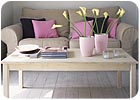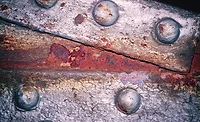An Effective Driver for Innovation in MDF

Versatile, adaptable, economical and flexible in use - medium density fiberboard (MDF) has proven over many years that, for the furniture industry, it is the ideal substitute for solid wood panels. Composed of selected wood fibers pressed together with a combination of resins and adhesives, MDF panels are compact, dense and homogeneous, so they can be routed, cut and perforated in any direction.
Now, innovative advances developed in powder coatings technology promise to expand the MDF finishing industry's design options even further, while introducing significant cost, environmental and process benefits.
Powder coatings are not new; they have been in use in the metal finishing industry for many years. After a relatively slow start, their use grew phenomenally fast as metal finishers recognized the enormous benefits of powder coating when compared with issues surrounding the use of conventional liquid paint processes. These included:
- Waste product was lost to the spray cabinet, down the drain and to the environment.
- VOC emissions and expensive waste treatment.
- Multiple liquid coats require drying or curing and then sanding at each stage - time, energy, labor and space consuming.
- Difficulties with coating odd-shaped products.
It didn't take long for the metal finishing industry to opt for the significant cost and process benefits of powder coating.

Powder Coatings for MDF
These same issues have also plagued the MDF coating industry; so MDF and powder coatings manufacturers, as well as processing equipment suppliers, have worked hard to develop a range of products, services and solutions that now put powder coating technology firmly within the range of coatings the MDF finishing industry can choose from today and in the future.It was not easy, however. The principal obstacle centered around the fact that powder attaches to the substrate electrostatically, requiring that the substrate is also charged. Then the powders had to be melted at temperatures that threatened to damage the substrate's structure.
Now, thanks to the careful selection of wood fibers, additives and resins, heat-resistant MDF products are commercially available that are sufficiently conductive for the electrostatic spray process, while powder coating manufacturers have developed MDF-specific powder coatings that offer low melt-point and high-performance finishes.
At Rohm and Haas Powder Coatings, we identified the MDF market several years ago as a significant new opportunity for our products and were one of the first companies to really develop a specific range for the market. With a process temperature that is far lower than that of standard powder coatings, the Lamineer™ range, developed in the United States, protects MDF products from heat damage. At the same time it offers almost limitless colors, finishes and effects, resistance to abrasion, corrosion and chemical attack, and it eliminates the design limitations inherent in using PVC sheet laminates.
Tested and approved to U.S. industry standards, the range also passes the UK's Furniture Industry Research Association's Standard 6259 1999 Test to "Horizontal Surfaces Severe Use" grade.
The Process
Prior to being powder coated, MDF typically will be sanded and possibly pretreated as it is for liquid paints. It is then preheated for 5 to 15 minutes to encourage its moisture content to migrate to the surface, making it sufficiently conductive to attract and hold the electrostatically charged powder coating particles. Preheating also ensures outgassing of elements that would cause problems during coating.The heated panels are then powder coated, following which they are heated to melt the particles into a continuous coating that physically "locks in" to the substrate, ensuring adhesion and resistance. The subsequent curing and polymerization of the coating depends on the type of coating used.
There are two types of product: thermocure materials polymerize at relatively low temperatures using convection heat, IR radiation or, ideally, a combination; alternatively, low melt-point products polymerize on exposure to UV light. The curing technology chosen really depends on the client's existing equipment; UV curing is gentler on the substrate, but thermal curing can offer better overall physical and chemical resistance.
Advantages of Powder Coatings
The transition to powder coatings requires significant outlay in new equipment and a new approach to finishing, creating quite a hurdle for its adoption for MDF products. But as the metal finishing industry discovered decades ago, the costs and efforts of transition can be far outweighed by the technology's many advantages.Productivity. One-pass application using a fully automated continuous process, compared with 3-6 passes necessary for liquid paints. By eliminating several coating passes, manufacturers save on the labour and production costs of spraying, inter-coat sanding, drying and curing, while the time taken by the entire coating cycle is reduced from hours, even days, to minutes. This is particularly true where vertical processes are used, allowing simultaneous application to both sides of a panel.
Environment. Powder coatings contain none of the volatile VOC pollutants found in liquid paints, and the recycling capabilities of powder coatings in use provide recovery values in excess of 95 percent; this also results in reduced waste treatment costs.
Application Costs. Powder coatings cost about the same as plastic laminate processes but less than liquid paint processes due to ease of automation of application processes - increased productivity, reduced labour, reduced waste treatment costs.
Resistance. In just one pass, a 70 to 120 m- thick coating is achieved that protects the moisture-sensitive MDF substrate. Powder coatings typically are more flexible than liquid paints, and more abrasion, chemical and corrosion resistant.
Versatility. Although less resistant than PVC/MDF laminate composites, powder coatings, unlike laminates, can be used on edges, borders, indents and odd-shaped panels, as well as to encapsulate panels - which is impossible with plastic laminates. Here, PVC sheets are laminated to the MDF top and bottom and are sealed at the border using a different material. This can be a problem as if water gets under the seal, the MDF will expand, cracking the coating or covering.
Range. Like liquid paints, powder coatings come in a wide range of colors and finishes and, unlike PVC sheets, can be purchased in small lots to allow for design flexibility.

Ideal Uses for Powder Coatings
Powder coatings have a great deal of potential to expand the kitchen, office furniture, ready-to-assemble furniture and furniture accessories sectors, as Rohm and Haas Powder Coatings has seen in the United States, and more recently in Europe. Some of the Unites States' more enterprising large furniture designers and suppliers recognized the enormous advantages of these products and adopted the technology early on. This was powerful testimony to the advantages of powder coatings and it helped open the market to other manufacturers.In Italy, too, Rohm and Haas Powder Coatings works with top furniture design and manufacturing companies, using the advantages of powder coatings to open up a wealth of new design potentials.
One such company, a leading Italian supplier known for its top of the range kitchens, is now preparing a special range of powder coated kitchen cupboard panels that cannot be manufactured using other technologies. The panels incorporate an indent that has to be hand-sanded if they are liquid painted - a process that must be repeated for each of the coating passes. Powder coating eliminates this problem as it requires only one pass, and the process can be fully automated.
In a further initiative aimed at bringing powder coatings to the attention of the MDF industry and designers, Rohm and Haas Powder Coatings is active in Fiberpol, a working group that brings together Italy's powder coating and MDF manufacturers, equipment manufacturers and MDF job coaters, and which organized a design workshop where top designers and leading furniture manufacturers competed with each other to produce prototypes demonstrating the design potential in powder-coated MDF products. The initiative culminated in a final show at the 2004 edition of Milan's Furniture exhibition, creating what Fiberpol described as "An Industrial Design Culture" for powder coatings, increasing their value as an "effective driver for innovation."
Today, all the products and services that are necessary for the introduction of powder coating onto MDF substrates are in place. Given the cost, design, breadth of colors and finishes available, as well as the process and environmental advantages of the technology, it is only a matter of time before the market for powder coated MDF products really starts to take off.
For information on reprints of this article, contact Jill DeVries at devriesj@bnpmedia.com.
Links
Looking for a reprint of this article?
From high-res PDFs to custom plaques, order your copy today!






